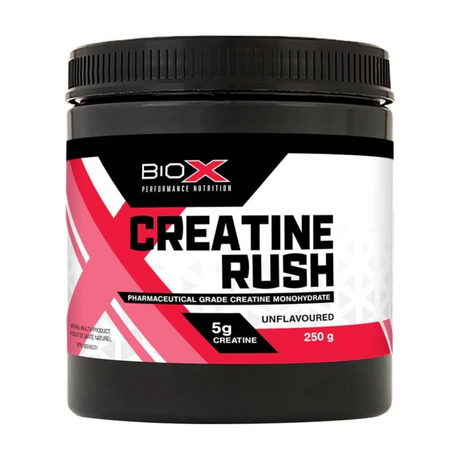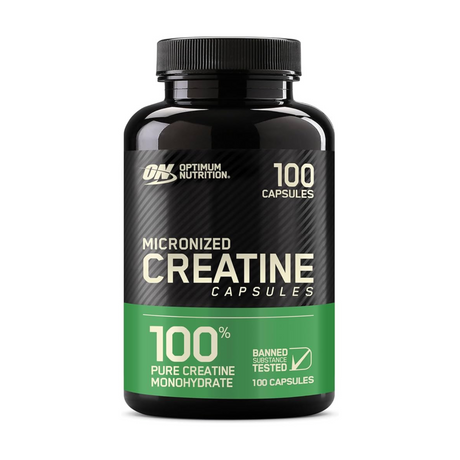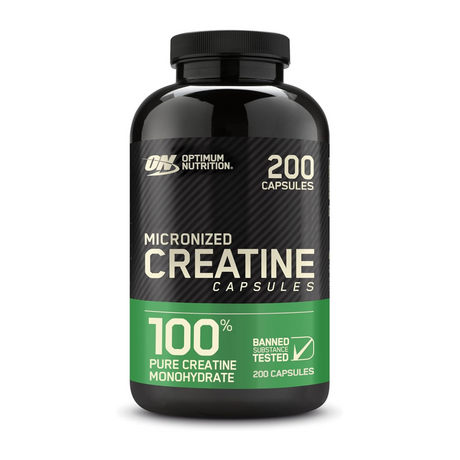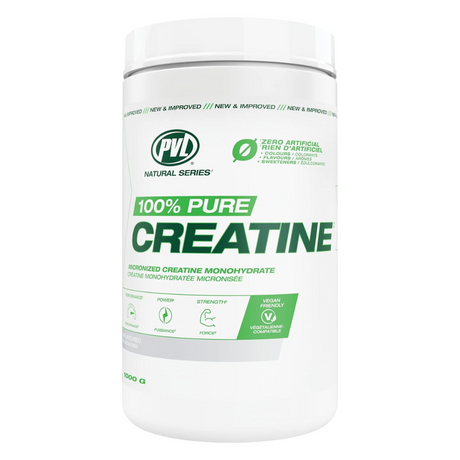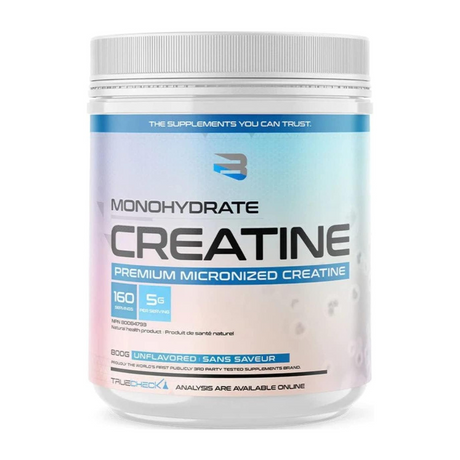March 25, 2025 | by FUEL SUPPLEMENTS
Creatine supplementation is widely used to enhance muscle mass, increase strength, and improve athletic performance. Found naturally in the body, creatine plays a key role in energy production for muscle cells, making it especially beneficial for short, intense workouts.
What This Guide Covers:
- The science behind creatine
- Different types of creatine
- How to use it safely and effectively
- Debunking common myths about creatine
Understanding Creatine: An Overview
What is Creatine? Creatine is an organic acid naturally produced by the liver, kidneys, and pancreas. It is derived from three amino acids—glycine, arginine, and methionine. Most creatine is stored in skeletal muscles, with smaller amounts found in the brain and heart.
How Does Creatine Work? Creatine is crucial in regenerating ATP (adenosine triphosphate), the body's main energy source. During intense exercise, ATP levels rapidly decline, leading to muscle fatigue. Creatine supplementation helps:
- Increase creatine phosphate levels in muscles
- Quickly restore ATP levels, providing more energy for workouts
- Delay muscle fatigue, allowing for longer, more intense training sessions
Creatine exists in two forms:
- Creatine – Found naturally in the body.
- Creatine phosphate – Stores high-energy phosphate groups that rapidly convert ADP back into ATP for continuous muscle contractions.
This is why creatine is crucial for high-intensity sports such as sprinting and weightlifting.

The Science Behind Creatine
How Creatine Powers Muscle Cells
When muscles contract, ATP breaks down into ADP (adenosine diphosphate), releasing energy. Creatine phosphate transfers a phosphate group to ADP, rapidly regenerating more ATP and sustaining energy levels.
Creatine is synthesized in the liver and kidneys using:
- Glycine
- Arginine
- Methionine
This process naturally maintains creatine levels, but dietary intake from sources like red meat and fish further supports it.
Creatine and ATP: Fueling Muscular Contractions
During exercise, ATP levels are quickly depleted. Creatine phosphate helps replenish ATP stores, delaying muscle fatigue and improving performance. This is why creatine is widely used in high-intensity training and explosive movements.
Creatine Monohydrate: The Gold Standard
The most studied and cost-effective form of creatine. Benefits include:
- Increases muscle strength
- Enhances endurance and recovery
- Proven safe with extensive research
Advanced Creatine Forms: Ethyl Ester & Micronized Creatine
Creatine Ethyl Ester: Claims faster absorption but lacks strong scientific backing.
Micronized Creatine: Utilizes smaller particles for enhanced mixability, providing performance benefits similar to those of monohydrate.
Liquid Creatine & Creatine Serum: Are They Effective? Despite marketing claims, scientific research does not support the superiority of liquid creatine or creatine serum over monohydrate. Stability and absorption concerns make them less effective options.

Benefits of Creatine Supplementation
Creatine increases ATP production, improving performance in sports like:
Weightlifting – Lift heavier weights
Sprinting – Run faster with sustained power
Endurance sports – Reduce muscle fatigue
Regular creatine use with resistance training leads to the following:
- Greater muscle mass
- Increased strength and power output
- Enhanced muscle protein synthesis
Creatine supplementation:
- Speeds up muscle recovery
- Reduces post-workout soreness
- Minimizes risk of injuries
Creatine is also beneficial for brain health, with studies showing improvements in:
- Memory and focus
- Cognitive function under stress
- Brain injury recovery support
How to Use Creatine: Practical Guide
1️ Loading Phase: 20g/day (split into 4 doses) for 5–7 days
2️ Maintenance Phase: 3–5g/day for long-term use
3️ Best Time to Take Creatine: Before or after workouts for maximum absorption
Pairing creatine with:
- Carbohydrates (dextrose) improves absorption
- Whey protein enhances muscle recovery
- Beta-alanine supports endurance
Debunking Creatine Myths
Does Creatine Harm the Kidneys?
🚫 Myth: Creatine damages kidney health.
✅ Fact: Studies confirm that creatine is safe for healthy individuals.
Does Creatine Cause Bloating & Water Retention?
🚫 Myth: Creatine causes excessive water weight.
✅ Fact: Creatine increases muscle hydration without causing bloating or fat gain.
Choosing the Right Creatine Supplement
What to Look for in a High-Quality Creatine
- Choose Creatine Monohydrate – The most researched form
- Third-Party Tested – Ensures purity and safety
- Avoid unnecessary additives
Where to Buy Creatine: Online vs. In-Store
- Online: More variety, convenience, better pricing
- In-store: Immediate access, personalized advice
Creatine is one of the safest and most effective supplements for boosting athletic performance, strength, and muscle recovery. Whether you're an athlete, fitness enthusiast, or just starting out, creatine can help you reach your fitness goals.

Frequently Asked Questions About Creatine
What is the best time of day to take creatine?
There isn’t a single “best” time to take creatine, but studies suggest two optimal times:
Post-Workout: Consuming creatine after your workout, paired with a source of carbohydrates and protein, may enhance muscle recovery and absorption.
Pre-Workout: Some research suggests taking creatine 30–60 minutes before exercise can help boost energy availability during high-intensity workouts.
Key Tip: The most important factor is consistency—taking creatine daily is more important than the exact timing.
Can I take creatine on rest days?
Yes! Taking creatine on rest days helps maintain muscle creatine stores, ensuring continued benefits.
Recommended Approach:
- On workout days, take 3–5g before or after exercise.
- On rest days, take 3–5g with a meal to maintain high creatine levels in your muscles.
How long should I use creatine before taking a break?
Creatine is considered safe for long-term use, and there is no scientific evidence to suggest a need for cycling (taking breaks).
However, some people follow a cycling approach:
1️ Loading Phase – 20g/day (split into 4 doses) for 5–7 days.
2️ Maintenance Phase – 3–5g/day for 8–12 weeks.
3️ Break (Optional) – Some users take a 4–8 week break, but this is not necessary.
Latest Research: The continuous use of 3–5g per day is considered completely safe and does not require cycling.
Is creatine suitable for vegetarians or vegans?
Yes! Vegetarians and vegans may benefit the most from creatine supplementation because they do not consume animal-based sources of creatine (e.g., red meat and fish).
Key Benefits for Vegans & Vegetarians:
✅ Higher brain and muscle creatine stores compared to those who get creatine from food.
✅ Improved strength, endurance, and muscle recovery.
✅ Enhanced cognitive function and mental clarity.
Best Option: Look for vegan-friendly creatine monohydrate, which is synthetically made and 100% plant-based.
Does creatine cause weight gain?
Creatine does not cause fat gain, but it can lead to a small increase in weight due to increased water retention in the muscles.
What to Expect:
- The initial weight gain (1–3 lbs in the first week) is due to muscle water retention, not fat.
- Over time, creatine supports muscle growth, resulting in gains in lean body mass.
Bottom Line: Creatine helps build muscle, not fat. It makes muscles appear fuller and more defined, not bloated.
Can creatine help with weight loss?
Creatine does not directly burn fat, but it can support weight loss by:
✔ Increasing workout intensity, allowing you to burn more calories.
✔ Preserving muscle mass, which boosts metabolism.
✔ Enhancing recovery, helping you stay consistent with exercise.
Best Way to Use Creatine for Fat Loss:
- Combine creatine with a calorie-controlled diet and strength training.
Is creatine safe for women?
Yes! Creatine is just as effective for women as it is for men.
Benefits of Creatine for Women:
✅ Increased strength and lean muscle mass.
✅ Improved endurance and recovery.
✅ Helps preserve muscle and bone density, especially for women over 40.
Key Tip: Women should take 3–5g of creatine monohydrate daily for best results.
Can creatine cause kidney or liver damage?
🚫 No! This is a common myth.
✅ Scientific research shows that creatine does NOT cause kidney or liver damage in healthy individuals.
Who Should Be Cautious?
- Those with pre-existing kidney disease or liver conditions should consult a doctor before taking creatine.
- Drinking plenty of water (at least 8–10 cups per day) is recommended while using creatine.
Bottom Line: Creatine is safe when used as directed.
Does creatine cause dehydration or muscle cramps?
🚫 No! Another myth.
✅ Studies show creatine improves hydration by drawing water into muscle cells, reducing the risk of dehydration and cramps.
Tips to Avoid Dehydration:
- Drink at least 2–3 liters of water daily.
- Take creatine with electrolytes or carbohydrates for better absorption.
Can I take creatine with coffee or caffeine?
Yes! Creatine and caffeine can be taken together and are often combined in pre-workout supplements.
Latest Research:
- Creatine + caffeine does NOT cancel each other out.
- However, excessive caffeine may cause dehydration, so drink more water when taking both.
Best Strategy: Take creatine with or after food instead of directly with coffee to avoid potential stomach discomfort.
How long does it take for creatine to work?
Short Answer: 5–7 days with loading, 3–4 weeks without loading.
How It Works:
- With a loading phase (20g/day for 5–7 days), muscles become saturated more quickly, and effects are observed within 1 week.
- Without loading, taking 3–5g/day reaches full effect in 3–4 weeks.
Pro Tip: Keep taking 3–5g daily to maintain results!
Creatine is one of the safest and most effective supplements for muscle growth, strength, and endurance. It’s backed by over 500 scientific studies proving its benefits and safety. Whether you're an athlete, fitness enthusiast, or just starting out, creatine can help you achieve your goals more quickly.
Still have questions? Please drop them below, and we’ll answer them.
